
South Kalimantan is a province of Indonesia. It is the smallest province in Kalimantan, the Indonesian territory of the island of Borneo. The provincial capital was Banjarmasin until 15 February 2022 when it was legally moved to Banjarbaru. The population of South Kalimantan was recorded at just over 3.625 million people at the 2010 Census, and at 4.07 million at the 2020 Census. The official estimate as at mid 2023 was 4,221,929. One of the five Indonesian provinces in Kalimantan, it is bordered by the Makassar Strait in the east, Central Kalimantan in the west and north, the Java Sea in the south, and East Kalimantan in the northeast. The province also includes the island of Pulau Laut, located off the eastern coast of Kalimantan, as well as other smaller offshore islands. The province is divided into 11 regencies and 2 cities. South Kalimantan is the traditional homeland of the Banjar people, although some parts of East Kalimantan and Central Kalimantan are also included in this criterion. Nevertheless, South Kalimantan, especially the former capital city Banjarmasin has always been the cultural capital of Banjarese culture. Many Banjarese have migrated to other parts of Indonesia, as well as neighbouring countries such as Singapore and Malaysia. In addition, other ethnic groups also inhabit the province, such as several groups of the Dayaks, who mostly live in the interior part of the province, as well as the Javanese, who mostly migrated from Java due to the Transmigration program which dated from the Dutch colonial era. It is one of the provinces in Indonesia that has a larger population than Mongolia.
Negara Daha was a Hindu kingdom successor of Negara Dipa that appears in the Hikayat Banjar. It was located in what is now the Regency of Hulu Sungai Selatan, Province of South Kalimantan, Republic of Indonesia.
Kiras Bangun, also known as Garamata is a national hero of Indonesia.
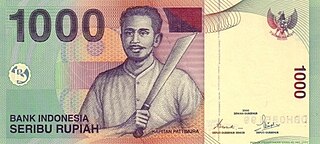
Thomas Matulessy, also known as Kapitan Pattimura or simply Pattimura, was a famous Ambonese soldier who became a symbol of both the Maluku and Indonesian struggle for independence, praised by President Sukarno and declared a national hero by President Suharto. He has several namesakes in both the Netherlands and in the Indonesian archipelago.

Air Vice-Marshal Abdul Halim Perdanakusuma, better known as Halim Perdanakusuma, was an Indonesian airman and National Hero of Indonesia.

The Banjarmasin War (1859–1863) was a war of succession in the Sultanate of Banjarmasin, as well as a colonial war for the restoration of Dutch authority in the eastern and southern section of Borneo.
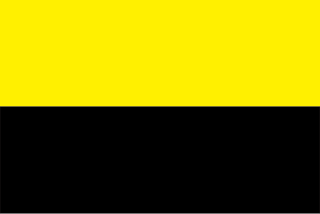
Sultanate of Banjar or Sultanate of Banjarmasin was a sultanate located in what is today the South Kalimantan province of Indonesia. For most of its history, its capital was at Banjarmasin.

Patuan Bosar SinambelaginoarOmpu Pulo Batu, better known as Si Singamangaraja XII, was the last priest-king of the Batak peoples of north Sumatra. In the course of fighting a lengthy guerrilla war against the Dutch colonisation of Sumatra from 1878 onwards, he was killed in a skirmish with Dutch troops in 1907. He was declared a National Hero of Indonesia in 1961 for his resistance to Dutch colonialism.
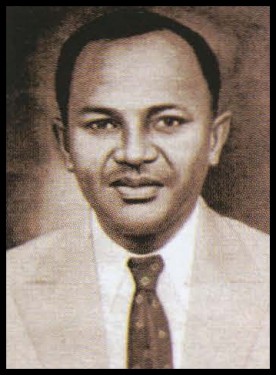
Teungku Nyak Arif was an Acehnese nationalist and National Hero of Indonesia. He has been given the nickname Rencong of Aceh, after the traditional Acehnese weapon, for his bravery.

Siti Walidah, better known as Nyai Ahmad Dahlan, was a female emancipation figure, wife of Muhammadiyah founder Ahmad Dahlan, and National Hero of Indonesia.
Second Sergeant Usman bin Haji Muhammad Ali, also spelt Osman bin Haji Mohamed Ali, was an Indonesian marine and convicted murderer. He uses the aliases Janatin or Usman Janatin during his task of bombing the MacDonald House, which killed three people and injured 33 other people. Usman was executed alongside his accomplice Harun Said for the murders of the three deceased victims from the MacDonald House bombing.

Mohammad Husni Thamrin was a Eurasian-Betawi political thinker and Indonesian nationalist who advocated for the independence of the Dutch colony in the East Indies. After his death, he was regarded as an Indonesian National Hero.

Raden Ajeng Kustiyah Wulaningsih Retno Edhi (1752–1838), better known as Nyi Ageng Serang, is a National Hero of Indonesia.
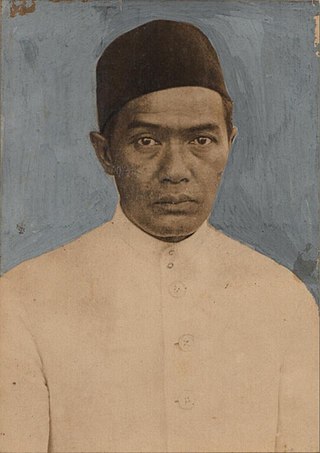
Mas Mansoer was an Indonesian religious leader who served as the 4th chairman of Muhammadiyah from 1937 to 1942. He was declared a national hero by President Sukarno in 1964.

Air Commodore Iswahyudi was an Indonesian airman and National Hero. On 14 December 1947, the plane he was flying with Halim Perdanakusuma crashed off the coast of Tanjung Hantu Hill, Perak, Malayan Union. Halim's body was later found, but Iswahyudi's was never recovered.
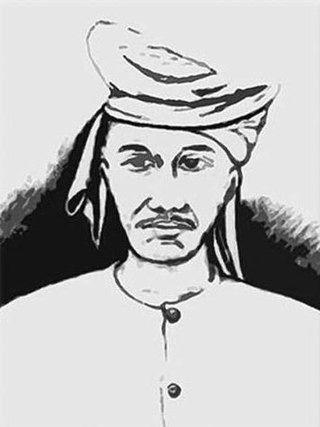
The Nuku Rebellion was an anti-colonial movement that engulfed large parts of Maluku Islands and Western New Guinea between 1780 and 1810. It was initiated by the prince and later sultan of Tidore, Nuku Muhammad Amiruddin, also known as Prince Nuku or Sultan Nuku. The movement united several ethnic groups of eastern Indonesia in the struggle against the Dutch and was temporarily successful, helped by an alliance with the British East India Company. However, the movement was defeated after the demise of Nuku, and Maluku was restored under European rule. In 1995, Nuku was officially appointed a National Hero of Indonesia.

A. A. Hamidhan, is the popular name of Anang Abdul Hamidhan, an Indonesian freedom fighter and journalist from South Kalimantan. He established the daily Soeara Kalimantan in 1930. It was he who brought news of Indonesia's unilateral declaration of independence to Borneo.
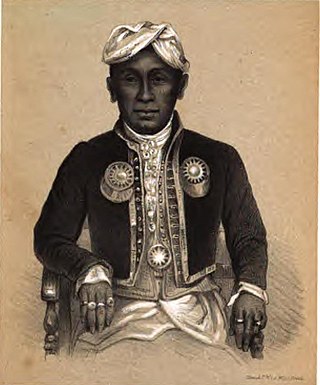
Sultan Hidayatullah II of Banjar, known also as Pangeran Hidayatullah, Sultan Hidayat or simply Hidayat, was a sultan-pretender of the Sultanate of Banjar and a leader of the Banjarese rebels in the Banjarmasin War.

Mohammad Noor, known by his Indonesian name Pangeran Mohammad Noor and also written as P. M. Noor, was an Indonesian politician, independence fighter and first Governor of Kalimantan. He was also member of the Investigating Committee for Preparatory Work for Independence and served as the Minister of Public Works between 1956 and 1959.


















